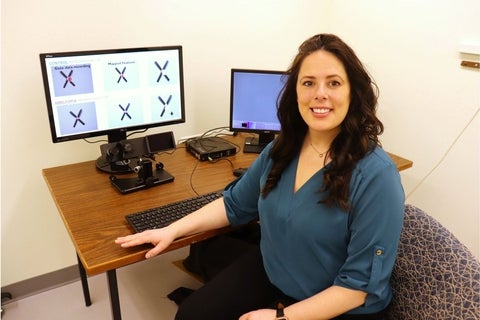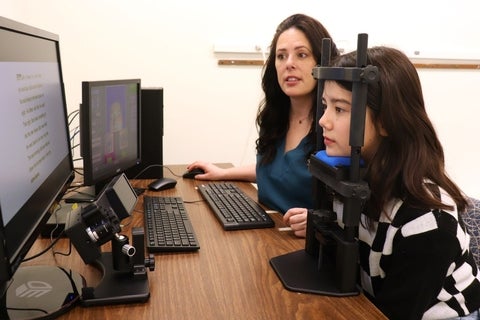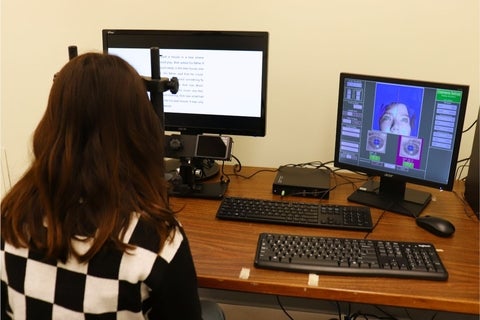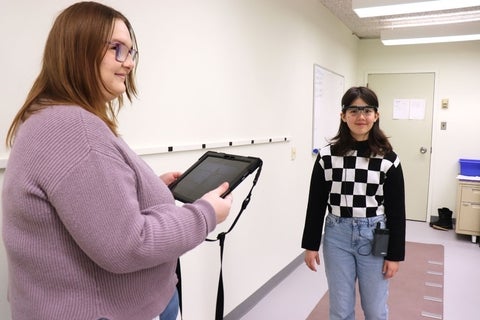Dr. Krista Kelly is working to better understand how ‘lazy eye’ affects children’s everyday lives

When Krista Kelly was seven, she was diagnosed with amblyopia, a vision condition that affects three to five percent of children and is often referred to as “lazy eye.” Today, as an assistant professor at the University of Waterloo School of Optometry and Vision Science, Kelly is researching the consequences of childhood eye conditions such as amblyopia with the goal of informing better treatments.
In people with amblyopia, the two eyes don’t communicate equally well with the brain. The problem is most often caused early in life, when the brain is still developing, if one eye is misaligned or has a significantly worse prescription than the other.
The brain comes to rely on information from the “good” eye and suppresses the information from the “bad” amblyopic eye. Over time, this weakens the connection between the “bad” eye and the brain. Even when the eye condition is addressed through interventions such as glasses or eye alignment surgery, the amblyopic eye continues not to see as well, with depth perception often affected.
Like most children with amblyopia, Kelly was treated by having her “good” eye patched for hours a day, forcing the brain to rely more on the information coming from the weaker eye. In her case, treatment was considered successful – she achieved a fairly good visual acuity of 20/32 in her weaker eye, though she still has issues with depth perception. When she finished treatment, she thought she was done with amblyopia.
As it turned out, amblyopia wasn’t done with her.

Krista Kelly tracking the eyes of a child as she reads
Kelly did her undergraduate degree in psychology at the University of New Brunswick. Interested in neuroimaging, she went on to a master’s at York University’s Centre for Vision Research, which offered a chance to learn neuroimaging techniques. She stayed for a doctorate, researching vision in adults who had one eye removed in childhood and how disruption in vision can affect development.
After her PhD, Kelly secured a postdoctoral research position at the Retina Foundation of the Southwest in Dallas, Texas. Her supervisor was Dr. Eileen Birch, a renowned expert on amblyopia. Under Birch’s mentorship, Kelly won a prestigious National Eye Institute-National Institutes of Health Pathway to Independence Award. This award funded two years of her postdoctoral fellowship and gave her three years of independent research funding, which enabled her to become director of the Vision and Neurodevelopment Lab, also at the Retina Foundation of the Southwest.
Since she came to Waterloo in April 2023 – she’s the newest faculty member at the School – Kelly has continued working to better understand how amblyopia affects children’s everyday lives.
“Usually, clinicians focus on treating visual acuity problems, and once patients are at a good point with those, they’re on their way. But depth perception problems can really affect children – and adults for that matter – and they’re a lot harder to treat,” says Kelly.

Kelly and her colleagues have found many issues that go along with amblyopia – problems with eye movements, reading, balance and other fine and gross motor skills. Then there are the social and emotional ramifications.
“I’ve collaborated with researchers who found that children with amblyopia tend to have lower perceptions of themselves,” Kelly says. “They think they’re not as good as their peers at academics, physical activity or social interaction with their peers.”
One major area of research for Kelly is on reading. Research she conducted found children with amblyopia read 25 percent slower than their peers. They also fill out multiple choice bubbles 28 percent slower.
“These are problems because standardized tests are timed. Most children with amblyopia won’t get any academic accommodations because when they see with both eyes, they have 20/20 vision, so you wouldn’t know that they’re struggling,” says Kelly.
Currently, Kelly is using an eye tracker to research how amblyopic children’s eyes move. Her research has found they are slower to move their eyes and that their gaze is unstable. In other words, far from being lazy, their eyes move more than is typical.

Master's student Lauren Hoare works with a child wearing eye tracking glasses as she walks on a GAITRite gait analysis walkway
Another area of Kelly’s research has to do with motor skills such as eye-hand coordination, balance and walking. For example, to research how children with amblyopia cope with stairs, she had a special set of stairs built that can track footfalls and that can be used in conjunction with a wearable eye tracker to see where children look while they’re walking.
The overarching aim of Kelly’s research is to better understand the relationship between eye movement problems and motor problems so this can serve as the basis for creating better treatment methods.
“I want to understand how these eye conditions impact children because we know that visual acuity is not the only problem,” says Kelly. “The final step will be to create interventions that will help, because maybe if we can intervene early in life, these issues won’t persist into adulthood.”